1.4 Collecting Practices
A Brief History of the Art Museum – Elizabeth Rodini – Smarthistory
When people think of museums, art museums most often come to mind—solemn places where visitors stand in silence contemplating neat rows of paintings. The exploratory, hands-on science centre, the contextualized ethnographic collection (think dioramas), and the storytelling of history museums seem worlds away. But all museums have a history to tell. Museums are more than containers of things; rather, they are complex reflections of the cultures that produced them, including their politics, social structures, and systems of thought.
The word “museum” comes from the nine Muses, the classical Greek goddesses of inspiration, though the famed “Museion” of ancient Alexandria was more like a university, with an important library, than a place for the display of objects. While scholars generally place the earliest museum (in the sense that we understand it today) in seventeenth or eighteenth-century Europe, there were earlier collections of objects and sites of display, including the public squares or fora[1] of ancient Rome (where statuary and war booty were exhibited), medieval church treasuries (for sacred and valuable objects), and traditional Japanese shrines where small paintings (ema, traditionally of horses) were hung to draw good favour.
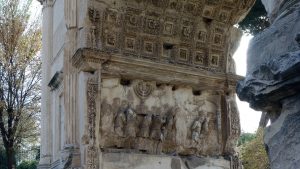
The modern museum, as a secular space for public engagement and instruction through the presentation of objects, is tightly bound to several institutions that arose simultaneously in 18th and 19th-century Europe: nationalism fused with colonial expansion; democracy; and the Enlightenment. Thus this historical essay and several others in this series on museums[2] focus largely on Europe and North America. The influence of the museum model, as a tool of colonialism but also as a site for local adaptation and self-definition in places other than the West, are two sides of an important coin that is just beginning to receive attention from art historians.
Wunderkammern
The nearest thing to a museum in early modern Europe were the Wunderkammern, or cabinets of wonders, assembled by curious nobles, wealthy merchants, and scholars. Emerging just as Europe was extending its reach into “new” continents and cultures, Wunderkammern were places to gather together, interpret, and show off the riches of the world. Some were literal cabinets, fitted with cupboards and drawers; others were rooms stuffed with animal, mineral, vegetal, and artistic treasures. Much like our museums—and differently from church treasuries and displays of war booty—Wunderkammern were intended to deepen people’s knowledge through the presentation of things.
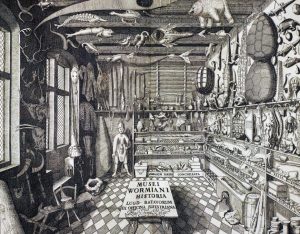

In most other ways, however, Wunderkammern differed from modern museums. They were the domains of the wealthy elite, typically located in a private palace and open only to the collector, his immediate circle, and the occasional visitor who was properly furnished with a letter of introduction. This intimacy meant that objects could be taken from shelves, handled, juxtaposed, and discussed before being returned to storage, often out of sight. Wunderkammern were more like private study collections than the art museums most of us know today.
As is true of all museums, the organization of the Wunderkammern mirrored the intellectual outlook of their day. “Wonders”— extraordinary objects like featherwork from New Spain[3] or a spiraled unicorn horn (actually the tusk of a narwhal)—were among the most valued, as marvelous expressions of creation. At the same time, Wunderkammern were all-encompassing, ideally including every kind of object, both natural and artificial (i.e. made by human hands) from every corner of the world.
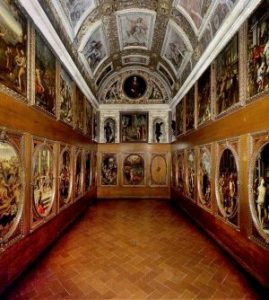
Wunderkammern were seen as “microcosms” of God’s creation: the cosmos, Greek for “universe,” was encapsulated in one, miniaturized reflection of its literal awesomeness. This was an age of rising scientific interest, but this interest was still thickly wrapped in religious covers. In the worldview of elite European collectors, all elements of the cosmos were interconnected in a perfectly balanced web of meaning. If one laid out a Wunderkammer in imitation of this divine plan, the plan would be revealed. Francesco I de’ Medici of Florence, for example, probably arranged his collection according to the four Aristotelian elements: earth, air, fire, and water. Objects as varied as armor, mirrors, and enamels were linked as fire-objects (since they were created using heat), pearls and narcotics (typically diluted for use) as water-objects, and so forth. Other Wunderkammern had other organizational systems, but they were typically rooted in visual or conceptual resemblance (e.g. fire=forge=armor).
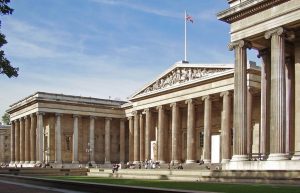
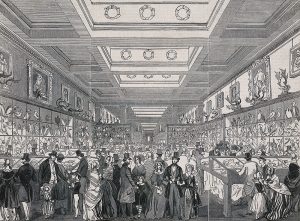
Toward the middle of the eighteenth century a different structure emerged, one associated with several important trends. One of these was the rise of the Enlightenment. This intellectual movement aimed to make sense of a world that— from the perspective of Europeans who were colonizing other places around the globe—was revealing new things that demanded new explanations. Enlightenment thinkers relied on the emerging tools of secular empiricism, or sense-based evidence, and proof through repetition—that is, the guiding concepts that lie at the root of modern science.

The British Museum[4] embodies the ideals of the Enlightenment. Founded in 1750 as a gift to the British nation by Sir Hans Sloane, its core collection consists of specimens he acquired as a medical doctor in the West Indian colonies (plants, birds, and seashells, for example) and objects he purchased from other explorers (including ethnographic and archaeological objects and manuscripts). These were eventually housed in an imposing building that featured an image of Britannia, the personification of the British Empire, at the apex of its great triangular pediment. This architectural reference to classical temples[5] was intentional, symbolizing a space of protection and prestige, and the nationalist imagery above its entrance made it clear just who controlled the materials within—much of it from the colonies.
The British Museum inherited the all-inclusive approach to collecting characteristics of the Wunderkammern, though it focused on typical objects, or specimens, as much as exceptional ones. Not for nothing are the British Museum and its kin termed “encyclopedic” (encyclopedias were another product of the 18th century). Rather than mirroring the balanced, interwoven web of the divine microcosm, however, the new sciences emphasized differentiation and development as tools for an empirical understanding of the universe.

The rise of museums
Museums reflected and helped shape that outlook. The Enlightenment is when we begin to see specialized collections, including museums devoted only to art—the Capitoline (Rome, 1734), the Louvre[6] (Paris, 1793), and the Alte Pinakothek (Munich, 1836). Similarly, dedicated collections of plants (botanical gardens), animals (zoological gardens), and eventually natural history and ethnographic objects emerged. One key thing these collections shared was a scheme of linear, didactic layouts dedicated to narratives of development or progress.
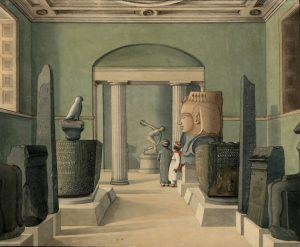
In art museums, this meant chronological arrangements subdivided by nation, local school, and artist and based in the comparison of visual forms: for instance, the idea that ancient art leads to the Renaissance, which leads to French Neoclassisicm,[7] or that Egyptian art was less “developed” than Greek art. Using different examples, this same history of art could be repeated in different places, much like a scientific demonstration or a proof. A similar general narrative continues to define many art museums today.
Museums and History, from Making History
Inside the Lost Museum, an interactive timeline of museum history
John Cotton Dana, “The Gloom of the Museum” (1917). Republished in Gail Anderson, ed. Reinventing the Museum: Historical and Contemporary Perspectives on the Paradigm Shift (Walnut Creek, Cal.: Rowman and Littlefield Publishers, Inc., 2004), pp. 13-29.
Larry J. Feinberg, “The Studiolo of Francesco I Reconsidered,” in The Medici, Michelangelo and the Art of Late Renaissance Florence (New Haven and London: Yale University Press, 2003), pp. 67-76.
Paula Findlen, “The Museum: Its Classical Etymology and Renaissance Genealogy.” Journal of the History of Collections, vol. 1, issue 1 (January 1989), pp. 59-78.
Carol Paul, ed., The First Modern Museums of Art: The Birth of an Institution in 18th– and 19th-Century Europe (Los Angeles: Getty Publications, 2012).
Attribution
“A brief history of the art museum” by Dr. Elizabeth Rodini for Smarthistory is licensed under Creative Commons Attribution-NonCommercial-ShareAlike 4.0 International License.
- For more information on the fora, see this article on the Forum Romanum (The Roman Forum) ↵
- View the second essay in the series, Museums and Politics: The Louve in Paris. The remainder of the series can be found at Understanding Museums. ↵
- To learn more about New Spain visit: Introduction to the Spanish Viceroyalties in the Americas ↵
- For more information on the British Museum, read Robert Smirke, The British Museum ↵
- Learn more about classical temples by reading, Introduction to Ancient Greek Architecture ↵
- Read more about the Louve in Museums and Politics: The Louvre, Paris ↵
- Read more about these art forms: Ancient Greece, An Introduction, Renaissance Art, Neoclassicism, An Introduction ↵
Early modern Europe is the period from the end of the Middle Ages to the beginning of the Industrial Revolution, roughly from the late 15th century through the late 18th century.
Wurderkammern is a German word meaning "wonder cabinet".
Francesco I de’ Medici was the Grand Duke of Tuscany from 1574 to 1587.
The West Indies are the groups of islands off the Atlantic coast of North and South America in the Caribbean Sea.

